The farmer who has dropped by the local soba store, a rickety old building that also doubles as a general store and post office, is an expansive character, speaking fondly and at Homeric length about the area in which he lives.
“In our town we have three treasures,” he says, taking a late morning sip from his glass of sake. “A good mountain, good water and an excellent road.”
The mountain he refers to is in fact Mount Komagatake, which forms the town’s picturesque backdrop. By “good water,” the farmer means the clear and bucolic springs that gurgle thereabouts and the “excellent road” he mentions is a reference to the Koshukaido, which links this rustic area of Japan with Tokyo.
For many years Hakushu village, tucked away in the depths of Yamanashi prefecture, could claim a fourth treasure – a colorful international festival featuring avant-garde performances, musicians, dancers and other artists. That, sadly, no longer takes place, but vestiges of the event remain. One of its original organizers, butoh dancer Min Tanaka, drawn by the beauty of the region, the traditional values of the villagers and the area’s surprising proximity to Tokyo, set up a dance collective here called the Body Weather Farm in the late 1980s and were soon joined by other artists. The dance workshops and courses at the farm have survived.
The busy Koshukaido links this area of Yamanashi with the capital but, thankfully, keeps most of the traffic firmly on its narrow strip, allowing this rustic area to go its own way largely unmolested. Until a few years ago, many residents of Hakushu, in fact, had never laid eyes on a foreigner. With the demise of the festival, the patina of rustic calm and neglect that lies like a mantle over the village has returned, despite the occasional appearance of a foreign dance student or erstwhile ecologist.
One of the best places to stay in Hakushu is at a government-run and subsidized complex called Verga (an abbreviation of “Verdant Garden”). The center is located in a pine forest, its sloping grounds running down to the attractive Ojiro River, its shallow, boulder-strewn bed, natural pools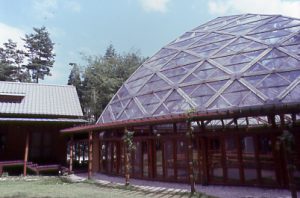 and sandy banks making it perfect for picnicking and bathing. The designers at Verga have worked overtime at getting the complex to blend in with the natural environment. Its chalets and bungalows are made of cypress and pine; its communal hot springs are set on a wooded slope. The complex also boasts a fine restaurant set in a geodesic dome surrounded by water and lawn, offering Japanese barbecues and a very decent French menu, an art gallery and small shop. Self-catering is popular here as each bungalow has its own fully equipped kitchen.
and sandy banks making it perfect for picnicking and bathing. The designers at Verga have worked overtime at getting the complex to blend in with the natural environment. Its chalets and bungalows are made of cypress and pine; its communal hot springs are set on a wooded slope. The complex also boasts a fine restaurant set in a geodesic dome surrounded by water and lawn, offering Japanese barbecues and a very decent French menu, an art gallery and small shop. Self-catering is popular here as each bungalow has its own fully equipped kitchen.
Although private transportation helps in this area, it is by no means essential and may even detract from undertaking the country romps, which are integral to the Hakushu experience. The area is covered in easily followed hiking trails, the most ambitious being the one up to the summit of Mount Komagatake itself. Hakushu village, an unassuming cluster of mostly older properties and a few more recent, tasteless ones, is worth exploring on foot for its shrines, kitchen gardens and old wooden farmhouses, some dating back to the Edo period. If you look at the central eaves of these old wooden houses and barns, you will notice that many have family names and emblems inscribed on medallion-shaped reliefs made from plaster, clay and straw.
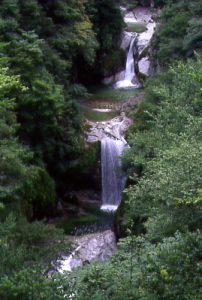 Hakushu lies in the shadow of Mount Komagatake, a peak from which the region’s excellent water springs in cool cascades and trickles even at the height of summer. This is good news for those who like their picnics accompanied by wine chilled in natural rock coolers in the river and streams that irrigate the area. Hakushu’s water is so good that it is bottled and sold all over the country. The district’s waterways form an intricate web of routes that can be turned, with the help of the local maps that are given out at the nearest station at Nirasaki and at the area’s minshukus, into walking trails. Sengafuchi, a waterfall and clear pool enclosed by wooded slopes, is an enchanting place. So is the mysteriously named God-Snake Waterfall, featured on brochures of the region. A trail leads from the waterfall to Takeu Komagatake Jinga, a truly rustic shrine built among rock boulders and moss in a pine and cryptomeria wood on the upper bank of the river. The wooden shrine has a number of interesting carvings, but its headstones and groupings of Buddhist and native figures – from Fudo, the guardian of hell, to the long-nosed Tengu, time-mottled but beautifully executed – form a fascinating collection of deities. Coming from the waterfall, the shrine is reached by crossing a wooden suspension bridge over the Ojiro River.
Hakushu lies in the shadow of Mount Komagatake, a peak from which the region’s excellent water springs in cool cascades and trickles even at the height of summer. This is good news for those who like their picnics accompanied by wine chilled in natural rock coolers in the river and streams that irrigate the area. Hakushu’s water is so good that it is bottled and sold all over the country. The district’s waterways form an intricate web of routes that can be turned, with the help of the local maps that are given out at the nearest station at Nirasaki and at the area’s minshukus, into walking trails. Sengafuchi, a waterfall and clear pool enclosed by wooded slopes, is an enchanting place. So is the mysteriously named God-Snake Waterfall, featured on brochures of the region. A trail leads from the waterfall to Takeu Komagatake Jinga, a truly rustic shrine built among rock boulders and moss in a pine and cryptomeria wood on the upper bank of the river. The wooden shrine has a number of interesting carvings, but its headstones and groupings of Buddhist and native figures – from Fudo, the guardian of hell, to the long-nosed Tengu, time-mottled but beautifully executed – form a fascinating collection of deities. Coming from the waterfall, the shrine is reached by crossing a wooden suspension bridge over the Ojiro River.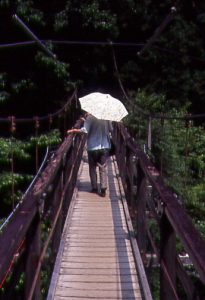
Water is not the only liquid identified with Hakushu. A Suntory whisky distillery lies in the eastern half of the district, located close to a rather grand shrine. Yamanashi, of course, is a serious wine-producing prefecture. Hakushu cultivates its own label at various small, family–run establishments and medium–sized wineries dotted throughout the region. The easiest to reach, perhaps, is the Charmant winery, a 20-minute walk from Verga. Reds, whites and roses are produced here at this winery that was established in 1940. Its whites – a Semillon and Chardonay among them – are the best. Visitors are welcome to wander around the winery, inspect the vineyards at the back and help themselves to a free tasting from the bottles on offer at its display shop where they sell local produce and cheeses selected to match their wines.
There is much to surprise and delight at Hakushu, and a ramble through the catchment area turns up more features in the landscape than just the peach orchards and the rice paddies for which the region is noted. What appear at first glance to be Palaeolithic stone circles, a granary silo, a rusting septic tank and a cache of incubator bags from the movie The Invasion of the Body Snatchers, turn out to be perfectly serious statements by contributing artists: installations no less, relics of Hakushu’s association with the art festival. Despite the industrial age feel of the materials – concrete, stainless steel and nylon – the works manage to blend their surfaces and contours in with the environment remarkably well. One, a car covered in leaf mold and overhung by a trellis of pipes that feel like a forest flyover, actually looked in danger of being overcome by the surrounding fecundity.
Locating these artworks is often easier said than done. Nature moves at a brisk pace out here in the Japanese countryside and several have already vanished, like Khmer ruins, into the undergrowth. Finding them can feel – and this is half the fun – more like a treasure hunt than art appreciation.
TRAVEL INFORMATION
Hakushu village is about two and a half hours from Tokyo by train and is located in Yokote-Daibo district, Hakushu-cho, Kitakama-gun, Yamanashi. The easiest way to get there is via the JR Chuo-Honsen limited express train, which leaves from Tokyo’s Shinjuku Station for Nirasaki. Buses to Hakushu are highly infrequent, so grab a taxi for the 20-minute ride. Accommodation at Verga (tel: 0551-35-2121) runs from campsite options in basic wooden chalets (¥4,000-15,000) to extravagant pine log houses with living rooms, a kitchen and private luxury baths (¥25,000 a night, up to six people can stay for the same price). The Charmant winery is a 20-minute walk from Verga. Wine can be boxed and sent home on request.
Story & Photos by Stephen Mansfield
From J SELECT Magazine, September 2004

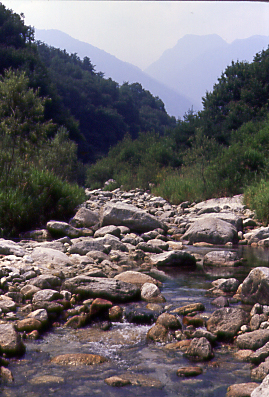

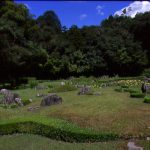

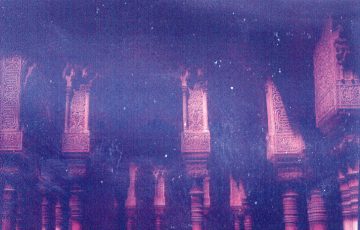
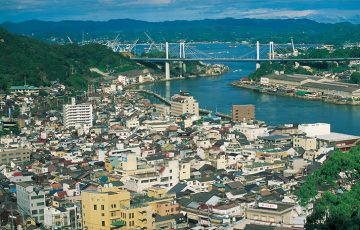
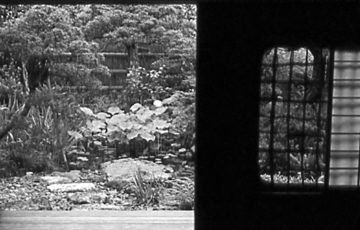

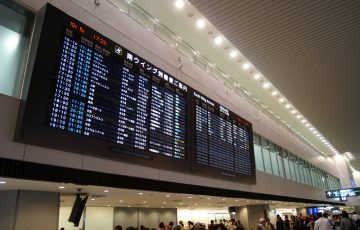
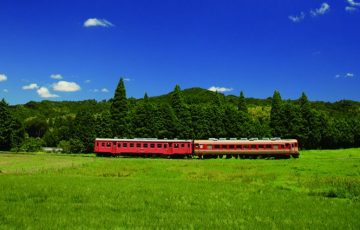
-360x230.jpg)
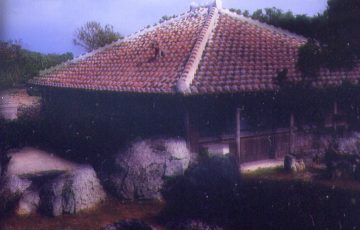


Recent Comments